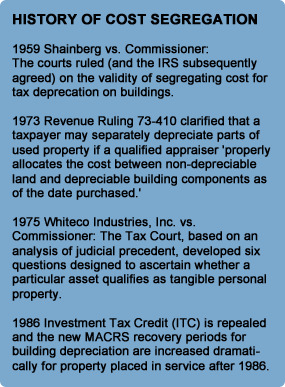Cost Segregation - Tax Depreciation Studies, and Their Use in
Adult
Assisted Living Industry.
 COST
SEGREGATION - INTRODUCTION
COST
SEGREGATION - INTRODUCTION
The principle goal of a cost
segregation study is to increase cash flow from constructed
buildings, purchased properties and renovations by accelerating
property depreciation and acquiring expenses.
Through this analysis, the
components of a building are reclassified into proper class
“lives” according to government legislation, case law, and IRS
revenue rulings/ procedures. Substantial tax savings can be
achieved by accelerating depreciation deductions.
The benefit of a cost
segregation study lies in the timing of tax payments. Assuming a
35% Federal tax rate, an 8% discount rate, half-year convention,
and no bonus depreciation, for every $1,000,000 of property
reclassified from 39 years has a cumulative present value of tax
deferral equaling approximately:
-
$195,000 for 5-Year Class
Property
-
$178,000 for 7-Year Class
Property
-
$108,000 for 15-Year Class
Property
In other words, the benefit is
approximately $.19 for every dollar reclassified as five year
class property from thirty-nine year class property.
COST SEGREGATION
AND ADULT ASSISTED LIVING FACILITIES - A CLOSER LOOK
Of special importance to the
assisted living industry is the landmark Hospital Corp. of America
case that reinstated component deprecation for medical related
facilities and other commercial properties.
The class life properties
involved in the HCA medical facility case included such components
as resilient/carpet flooring, wallpaper, process related equipment
and their electrical hookups including medical equipment, kitchen
equipment, nurse call and patient monitoring systems, and special
interior finishings related to patient living areas.
Additional cases and IRS
revenue rulings have added moveable interior drywall partitions,
communication systems, special interior lighting, and land
improvements including property drainage, paving, sidewalks, and
landscaping.
Based on our past experience
with assisted living facilities, an average property should yield
between 25% to 35% of reclassified property to total property
value.
Below are a few common benefits
resulting from a cost segregation study:
-
Rapid deprecation of current
assets.
-
Improved cash flow in first
years of ownership.
-
Possible lower insurance
rates and local property tax rates.
-
Proper classification of new
assets after major facility expansion.
Adult care facility owners
should be aware of the value and benefits of a study for their
property portfolio and should seek advice from accounting
professionals and engineering firms that have experience with cost
segregation studies.









